The Mask Guide
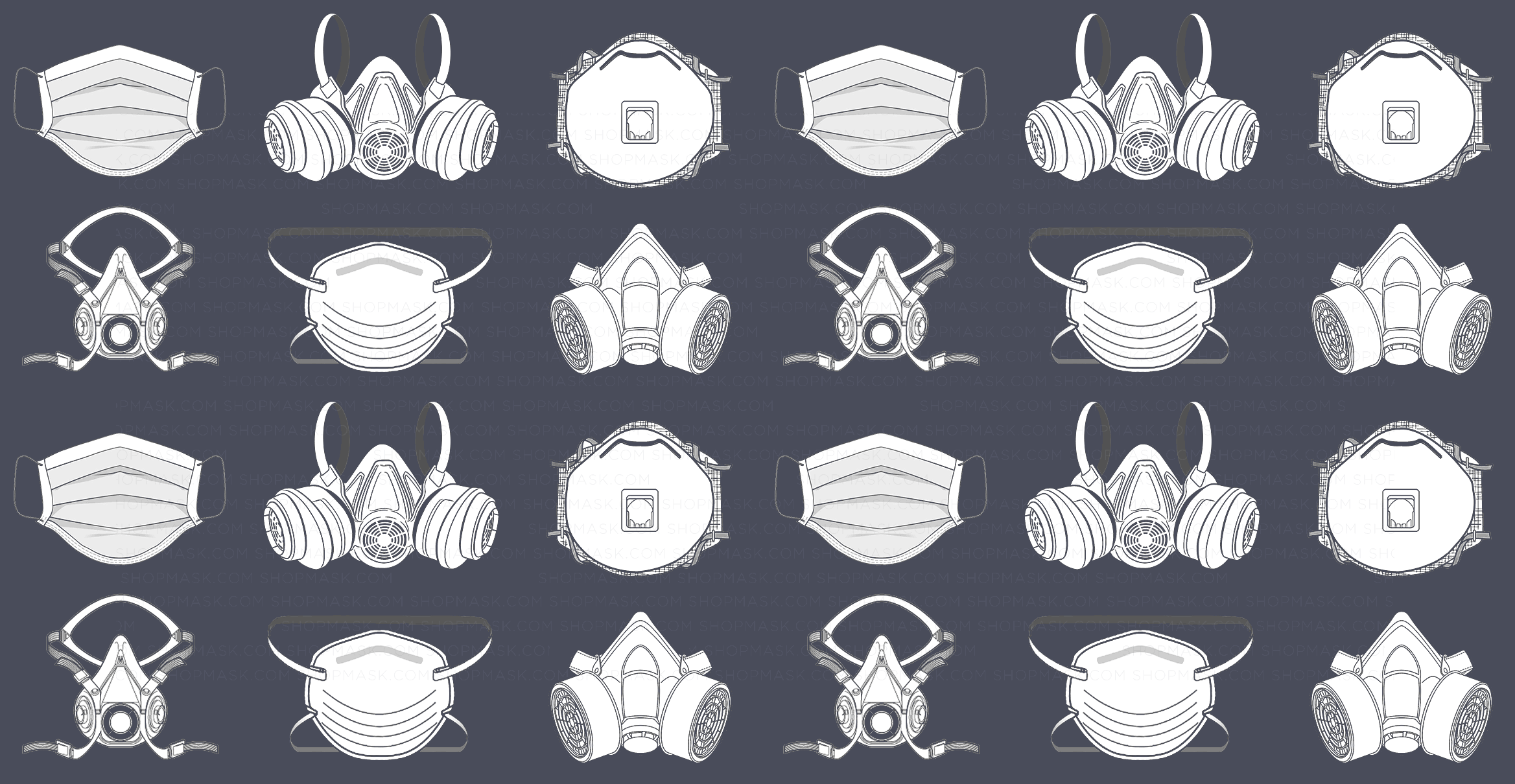
Introduction
Have you ever wondered what kind of mask you should use when air quality worsens in your area? With worldwide epidemics, bushfires in Australia, volcano eruption in the Philippines, increasing levels of urban pollution and an annual haze in a majority of countries, it might be useful information to brush up on.
With the increasing threat of new viruses and deteriorating air quality around us, masks and respirators have become a common accessory of daily use, especially in places like subway trains, buses and crowded streets. Sometimes adopted as a fashion statement in regions like Asia, or just as means to hide acne or a rushed morning makeup-less look, today's masks need to be functional, comfortable and attractive.
This guide created by SHOPMASK aims to get you updated about every aspect and details around types of air filtering masks, their applications, pros and cons. Enjoy, share, and read on!
A Diverse World
Respirators, masks, dust protectors, reusable, disposable, and the list goes on... The world of masks is diverse and full of nuances that define what protects more and what protects less. Yet, rates, grades and measurements are never totally precise, simply because no mask fits exactly the same, and no face looks exactly like another. Each person is different. Each breath is different. Each face is different, and each mask also fits differently. Materials are also different, and the environment (air pressure and conditions for example) is always different as well.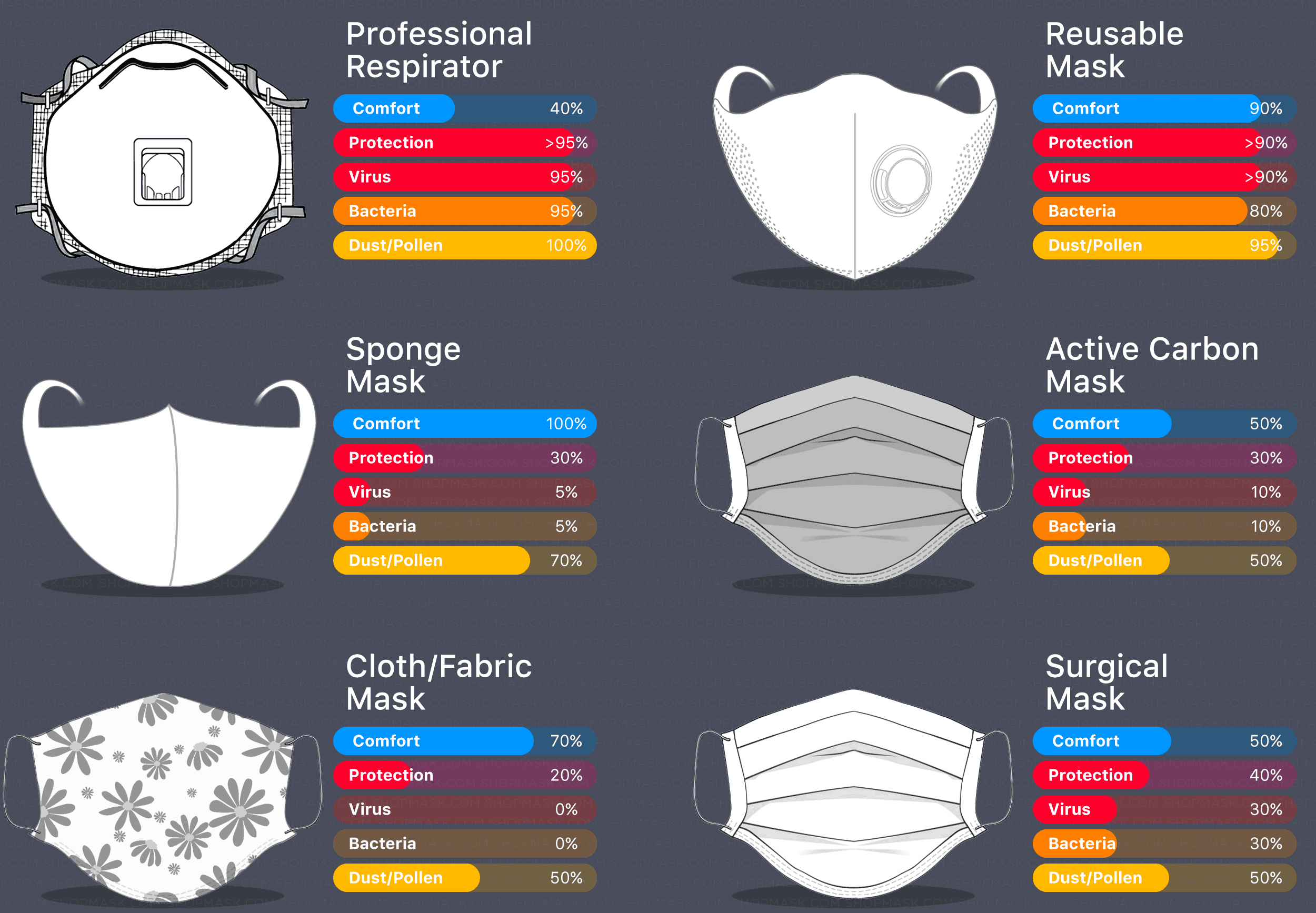 Nothing is more dangerous than wrongly wearing safety equipment and thinking that protection is guaranteed out of the box. As important as choosing the right mask, is wearing it properly, knowing its filtration capabilities, properties, materials, and so on. Even a N100 respirator can be rendered totally useless when badly fit or wrongly used.
Nothing is more dangerous than wrongly wearing safety equipment and thinking that protection is guaranteed out of the box. As important as choosing the right mask, is wearing it properly, knowing its filtration capabilities, properties, materials, and so on. Even a N100 respirator can be rendered totally useless when badly fit or wrongly used.
With all of this in mind, we've tried to compile a generic comparison list between different types of masks, but it's important to remember that these will never be precise numbers or ratings. Even a professional respirator, when wrongly used or badly fit, will protect as much as a disposable paper mask.
Respirators
 A respirator is a device designed to protect the wearer from inhaling hazardous atmospheres, including particulate matter such as dust and airborne microorganisms, as well as hazardous fumes, vapours and gasses. There are two main categories: the air-purifying respirator in which inhaled air is obtained by filtering a contaminated atmosphere, and the air-supplied respirator in which an alternate supply of breathable air is delivered. Within each category, different techniques are employed to reduce or eliminate noxious airborne contaminants.
A respirator is a device designed to protect the wearer from inhaling hazardous atmospheres, including particulate matter such as dust and airborne microorganisms, as well as hazardous fumes, vapours and gasses. There are two main categories: the air-purifying respirator in which inhaled air is obtained by filtering a contaminated atmosphere, and the air-supplied respirator in which an alternate supply of breathable air is delivered. Within each category, different techniques are employed to reduce or eliminate noxious airborne contaminants.Air-purifying respirators range from relatively inexpensive single-use, disposable face masks (sometimes referred to as dust masks) to more robust reusable models with replaceable cartridges (often called gas masks).
What does N95 mean?
The N95 respirator is the most common of the seven types of particulate filtering facepiece respirators. The N95 grade means the product is capable of filtering at least 95% of airborne particles if brand new and perfectly fit. In other words, a N95 respirator or mask still may allow 5% of airborne particles to pass unfiltered.
The U.S. National Institute for Occupational Safety and Health (NIOSH) has currently established nine classifications of medical and professional filtering respirators based on a combination of the respirator series and efficiency level.
The first part of the filter's classification indicates the series using the letters N, R, or P to indicate the filter's resistance to filtration efficiency degradation when exposed to oil-based aerosols (e.g., lubricants, cutting fluids, glycerine, etc.).
Definitions and intended use for each series is indicated below:
- N for Not resistant to oil. Used when oil particulates are not present.
- R for Resistant to oil. Used when oil particulates are present and the filter is disposed of after one shift.
- P for oil Proof. Used when oil particulates are present and the filter is re-used for more than one shift.
Classifications & Norms
In the United States, NIOSH is responsible for testing and certifying respirators to be used in the workplace. NIOSH not only reviews the manufacturer's test data, but also performs its own independent tests on the respirators in NIOSH's governmental laboratories to verify the manufacturer's results. The tests include filter efficiency, degradation, and flow rate, to name a few. In addition to testing the respirators during the submittal process, NIOSH also will periodically purchase respirators in the field and test them to make sure the respirators are performing to their original certification.
Once the respirator is initially approved, NIOSH will certify its classification as N, R, or P and its filter efficiency as 95 percent, 99 percent, or 99.97 percent. It is also important to note that even though a respirator just by its use often helps to prevent the wearer from contaminating the environment; it cannot be considered a surgical mask unless it has been cleared by the FDA.
In the United States, the National Institute for Occupational Safety and Health (NIOSH) defines the following categories of particulate filters as of 2011:
| Oil resistance | Rating | Description |
|---|---|---|
| Not oil resistant | N95 | Filters at least 95% of airborne particles |
| N99 | Filters at least 99% of airborne particles | |
| N100 | Filters at least 99.97% of airborne particles | |
| Oil resistant | R95 | Filters at least 95% of airborne particles |
| R99 | Filters at least 99% of airborne particles | |
| R100 | Filters at least 99.97% of airborne particles | |
| Oil proof | P95 | Filters at least 95% of airborne particles |
| P99 | Filters at least 99% of airborne particles | |
| P100 | Filters at least 99.97% of airborne particles |
European standard EN 149 defines the following classes of "filtering half masks" or "filtering face pieces" (FFP), that is respirators that are entirely or substantially constructed of filtering material:
| Class | Filter penetration limit (at 95 L/min air flow) | Inward leakage |
|---|---|---|
| FFP1 | Filters at least 80% of airborne particles | <22% |
| FFP2 | Filters at least 94% of airborne particles | <8% |
| FFP3 | Filters at least 99% of airborne particles | <2% |
Types of Respirators
Industrial/Professional Respirators- Are designed to reduce but cannot eliminate the wearer's exposure against certain airborne particles and aerosols free of oil.
- Form a tight seal over the mouth and nose.
- Employers and users are required to follow the OSHA Respiratory Protection Standard, 29CFR 1910.134, as well as other state or local regulations, as appropriate.
- These respirators (without valves) also can help prevent exhalation of contamination by the wearer to others in the work environment.
- Require fit-testing and must be adjusted to your face to provide the intended effectiveness of filtering 95 percent of particles with mass median diameter of 0.3 micrometers.
- Have specific use instructions, warnings, and limitations for use in industrial environments.
- Are NIOSH certified.
- Are not certified to be fluid resistant.
- Are designed to reduce but cannot eliminate the wearer's exposure against certain airborne particles and aerosols free of oil.
- Form a tight seal over the mouth and nose.
- Users are required to follow the directions from the manual or manufacturer's instructions
- Do not require fit-testing, but must be adjusted to your face to provide the intended effectiveness of filtering.
- Have specific use instructions, warnings, and limitations for use in urban environments.
- Are not NIOSH certified, but can be certified by a myriad of other official international health regulators
- Are not certified to be fluid resistant.
- Surgical N95 respirators are designed to reduce but cannot eliminate the wearer’s exposure to airborne biological contaminants. They do not eliminate the risk of illness, disease, or death.
- Form a tight seal over the mouth and nose.
- Require fit-testing and must be adjusted to your face to provide the intended effectiveness of filtering 95 percent of particles with a mass median diameter of 0.3 micrometers.
- Employers and users are required to follow the OSHA Respiratory Protection Standard, 29CFR 1910.134, as well as other state or local regulations, as appropriate.
- Have specific use instructions, warnings, and limitations for use in health care environments.
- Are NIOSH certified.
- Are fluid resistant to a certified level measured against a stream of artificial blood directed at the respirator.
Daily (Reusable) Masks
 Reusable masks sit somewhere between professional respirators and disposable or surgical masks. They combine the best of both worlds, offering, in many cases, high quality of filtering and optimal comfort, which is the biggest downside of medical or professional respirators.
Reusable masks sit somewhere between professional respirators and disposable or surgical masks. They combine the best of both worlds, offering, in many cases, high quality of filtering and optimal comfort, which is the biggest downside of medical or professional respirators.Masks of this type are made for daily use in cities and other urban areas, and they're designed to bring aesthetic and fashion factors to the product, something that you won't see in professional respirators. Style is subjective and relative to each one's tastes, but safety is not. High quality daily masks can offer a level of protection equivalent as a professional NIOSH N95-grade respirator. Famous brands like AirPop, Woobi or Smartmi use advanced filtering materials and patented technologies that make their respirators and masks as good as medical-use respirators, if not better.
Most reusable/daily masks adopt a 4 to 5-layers filtering system, which consists of a thin sandwich made of different materials that are used for different purposes. Some of these layers have filtering properties, while others are used for comfort, odor elimination or humidity purposes. It's very common for active carbon to be present in one of the layers due to its notorious odor filtering properties. Generally speaking, the more layers, the better the filtering, but the thickness comes with a cost: a harder breathing.
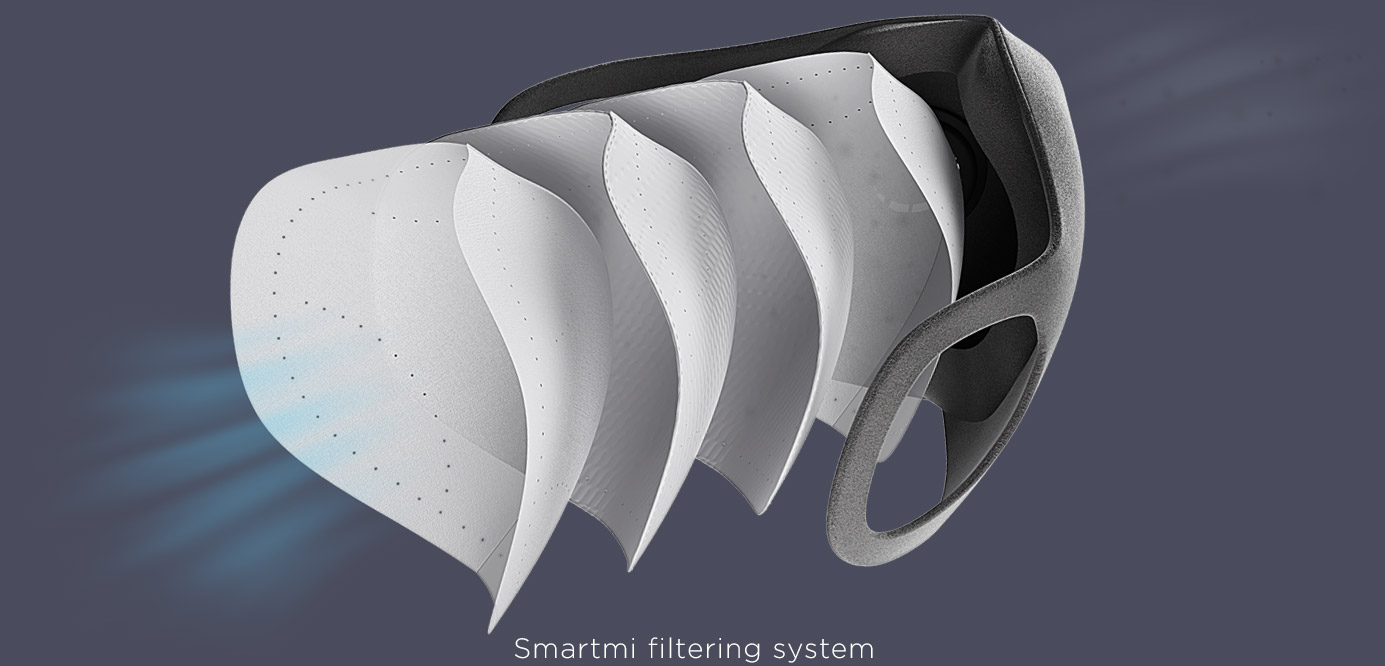
If comfort, daily use and aesthetics are important and high on your list, there's no doubt that reusable masks for daily/urban use are a good match. Some of these masks can be used for days or weeks, and some of them can even be cleaned and washed everyday. The only downside of these masks is price. After all, technology and good design doesn't come cheap.
Reusable daily masks are the closest you can get to being highly protected and comfortable for long hours of use, without looking clunky or funny, but it's very important to sanitize and wear them properly, and know exactly when to dispose them or replace their filters.
One of the greatest dangers that reusable masks pose is bacteria: Good quality reusable masks offer excellent filtration rates that are capable of greatly reducing the chance of viruses, aerosol particles and other undesirable elements passing through its filters. On the other hand, reusable masks are an attractive and very welcoming environment for bacteria growth.
The dangerous temptation to over-use them, combined with lack of proper cleaning and sanitizing after/before each time the mask is used, can result in bacteria growth both inside and outside the mask. If not taken care of, elements like sweat, saliva, makeup residues and skin oil can easily impregnate the inner side of the mask, allowing the growth of bacteria that will very likely be in direct and close contact with the user's mouth, nose and skin.
When using such types of masks, it's extremely important to follow the product service time instructions and not over use them longer than what they're supposed to last - even if they look perfectly good and beautiful. Proper sanitizing/cleaning is crucial if you use reusable masks.
Read more about ways to keep your reusable mask clean and safe (as long as they're supposed to be used) further down in this guide.
Sponge Masks
 Very popular in Asia, especially in Japan, sponge masks have been part of daily life and street fashion for quite a long time. They normally come in a wide spectrum of colors that appeal to an equally wide range of urbanites, from young people to salarymen.
Very popular in Asia, especially in Japan, sponge masks have been part of daily life and street fashion for quite a long time. They normally come in a wide spectrum of colors that appeal to an equally wide range of urbanites, from young people to salarymen.In obsessed-with-cleanliness Japan, not wearing a mask is considered impolite or even unacceptable in many situations. Taxi drivers, 7-11 cashiers, train station workers, policemen, shop sellers and even gangsters are just some examples of figures that are found constantly wearing not only masks, but also gloves.
Despite its large adoption and popularity, sponge masks are not very effective at stopping bacteria, viruses or even pollution from the city's air. In fact, sponge masks are less efficient than surgical masks in this aspect.
On the other hand, sponge masks are reasonably good at blocking dust, pollen, sunlight and smells. This type of mask popularity arosed from the need and market opportunity of having a product that sits between clunky, uncomfortable and unfashionable surgical masks, and something that better fit a constant and repetitive daily use without sacrificing style and comfort.
Sponge masks are one of the most comfortable type of masks one can buy, but if your needs or intentions are health-oriented, it's recommended that you use another layer of protection like a surgical mask under it.
Surgical Masks
 Surgical masks are not designed for use as particulate respirators and do not provide as much respiratory protection as an N95 respirator. Surgical masks provide barrier protection against droplets including large respiratory particles.
Surgical masks are not designed for use as particulate respirators and do not provide as much respiratory protection as an N95 respirator. Surgical masks provide barrier protection against droplets including large respiratory particles.Not to be confused with a respirator, a surgical mask (or procedure mask) is intended to be worn by health professionals during surgery and certain health care procedures to catch microorganisms shed in liquid droplets and aerosols from the wearer's mouth and nose.
It is easy to confuse a surgical mask, a surgical N95 respirator, and an industrial N95 disposable respirator with one another. The words "respirator" and "mask" are often used interchangeably when discussing respiratory protection. However, in fact there are many differences between them.
Surgical Mask Purpose or Intended Use
- May include masks labeled as surgical, laser, isolation, dental, or medical procedure masks
- Are primarily intended to protect the patient, not the wearer, from the wearer's saliva and respiratory secretions
- May also help protect the wearer against exposure to microorganisms, body fluids, and large particles in the air but are not tight fitting and likely have substantial inward leakage for particles and organisms
- Are designed to cover the mouth and nose loosely but are not sized for individual fit
- Are not NIOSH (National Institute for Occupational Safety and Health) approved
Surgical masks are popularly worn by the general public all year round in East Asian countries like China, Japan, Taiwan, and South Korea to reduce the chance of spreading airborne diseases and to prevent the breathing in of airborne dust particles created by air pollution. Additionally, surgical masks have become a fashion statement, particularly in contemporary East Asian culture bolstered by its popularity in Japanese and Korean pop culture which have a big impact on East Asian youth culture.
More recently, due to the rising issue of smog in South and Southeast Asia, surgical masks and air filtering face masks are now frequently used in major cities in India, Nepal and Thailand when air quality deteriorates to toxic levels. Additionally, face masks are used in Indonesia, Malaysia and Singapore during the Southeast Asian haze season. Air filtering surgical-style masks are quite popular across Asia and as a result, many companies have released masks that not only prevent the breathing in of airborne dust particles but are also fashionable.
Dust Masks
 A dust mask is a flexible pad held over the nose and mouth by elastic or rubber straps to protect against dust encountered during construction or cleaning activities, such as dusts from drywall, brick, wood, fiberglass, silica (from ceramic or glass production), or sweeping. A dust mask can also be worn to protect against allergens.
A dust mask is a flexible pad held over the nose and mouth by elastic or rubber straps to protect against dust encountered during construction or cleaning activities, such as dusts from drywall, brick, wood, fiberglass, silica (from ceramic or glass production), or sweeping. A dust mask can also be worn to protect against allergens.Dust masks are available both with and without a valve. These valves, normally made by companies like 3M, are small plastic housings with little vent openings that allow exhalation air and gasses to flow outside the shell, keeping the temperature lower inside the mask, allowing easier and more comfortable breathing that an unvalved mask.
A dust mask is worn in the same fashion as a paint mask or surgical mask, but it is dangerous to confuse the three because they each protect against specific airborne dangers. Using the wrong mask for a job can present a significant and possibly deadly danger as many dust masks with widely varied levels of protection may look similar, and even masks that do not protect against dust at all, such as paint masks and surgical masks. Misfitting masks are also a danger as they allow a material to bypass the mask entirely. A correct fit may not be as critical in masks that are intended to protect against splattering liquids or mists. Dust masks are manufactured to protect against only certain dangers, and do not protect against chemicals such as vapors and mists. For this reason, it is dangerous to confuse dust masks with paint masks.
Dust masks are a cheaper, lighter, and possibly more comfortable alternative to respirators, but may not provide as much protection, and may be more susceptible to misuse or poor fit.
Some dust masks include improvements such as having two straps behind the head (one upper and one lower), having a strip of aluminum on the outside across the bridge of the nose that can be bent for a custom fit, and having a strip of foam rubber on the inside across the bridge of the nose to ensure a good seal even if the aluminum on the outside does not fit.
Dust masks that incorporate these improvements into their design often receive the (USA) NIOSH N95 rating, which is indicated by the letters "N95" being printed directly on the mask, and are often the required rating for masks used by construction workers working around non-poisonous dusts.
A dust mask is also used to protect the wearer from inhaling dust or sand in a dust storm or black blizzard.
How to handle your mask
Knowing how to properly handle and store your mask is as important as choosing the right mask. When your mask is not in use, special care is important in order to keep it clean and free of dust, bacteria, mold and other undesirable elements that can put your health at risk or render your mask useless.When your reusable mask is not in use, make sure you keep or store it in a dry and dust-free space like a paper envelope or ventilated box. Keeping water, humidity away from it is important in order to avoid bacteria growth that comes from your breathing and mask usage. Humidity removal sachets can be helpful in this aspect.
When keeping your mask over a table or clean surface, never leave it with the inner side up. Always keep the inner side (the one your face touches) facing down, over a clean tissue or sheet of paper. This way you avoid dust and other elements from falling inside the area your face will touch afterwards.
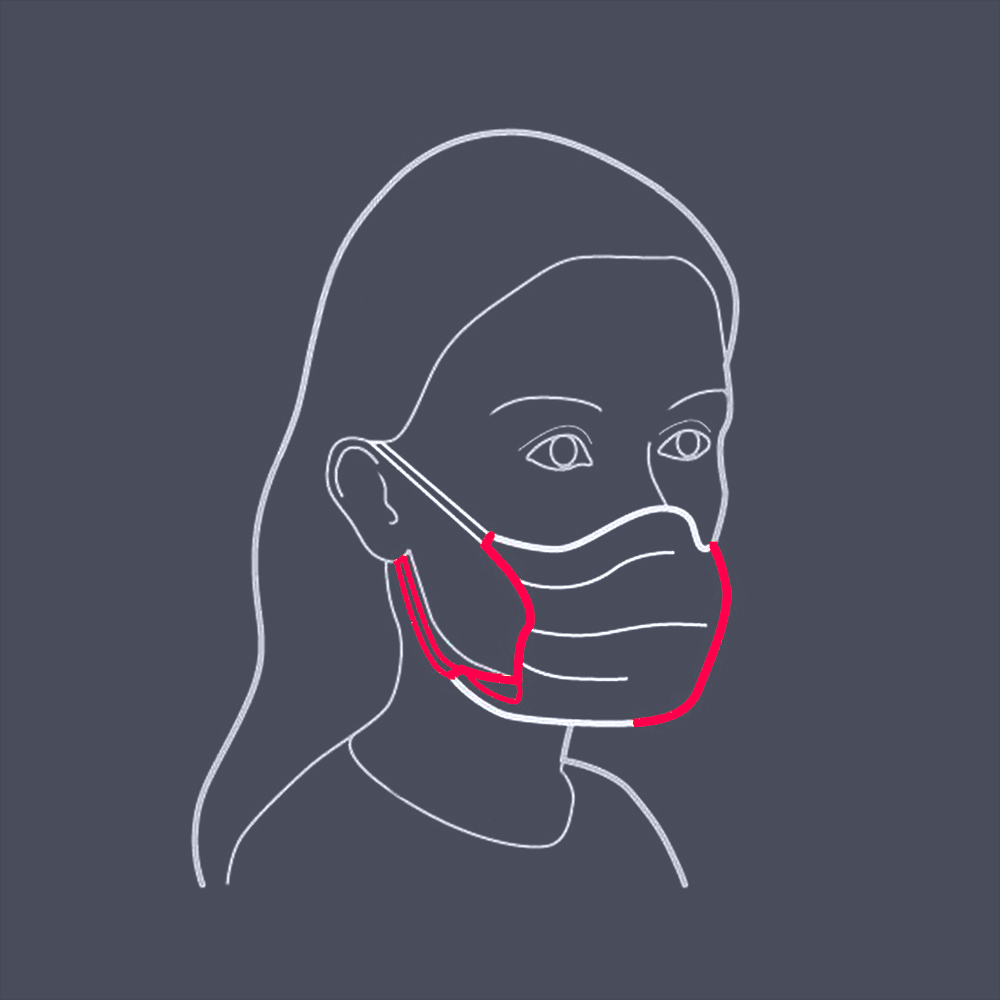 |
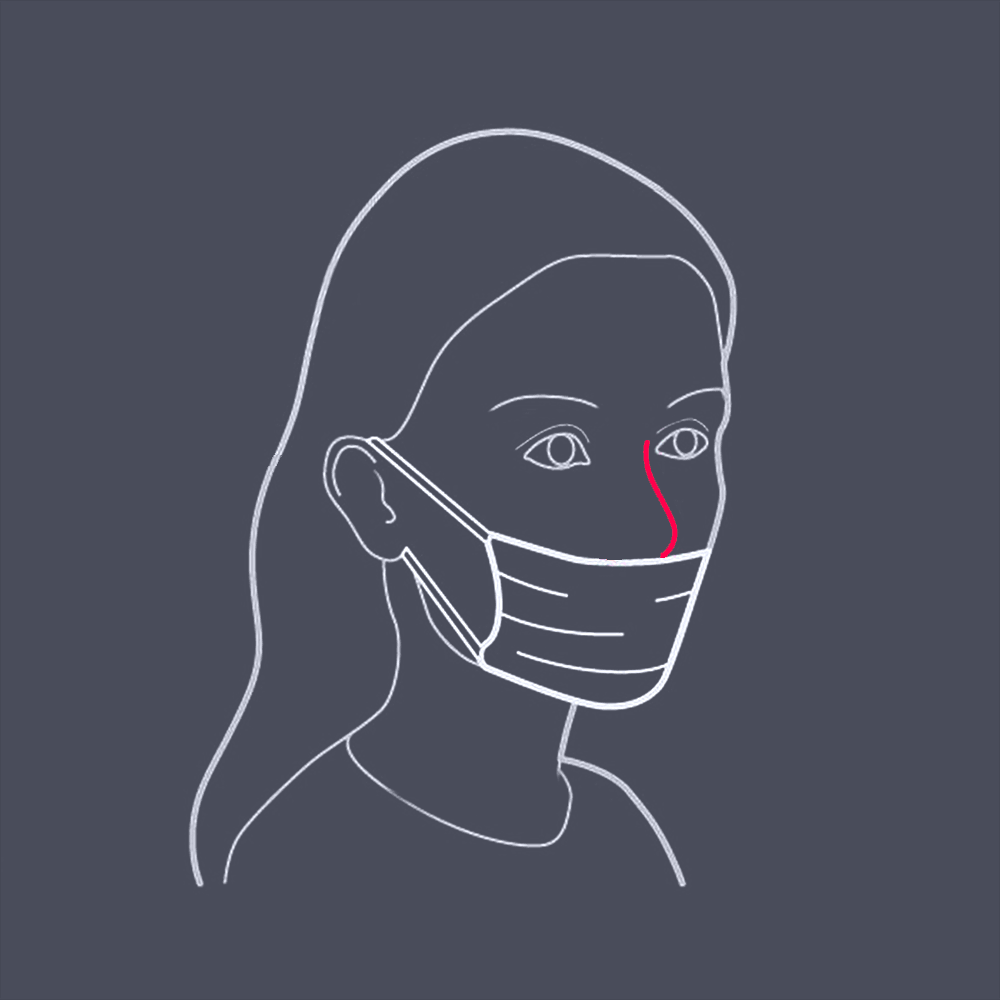 |
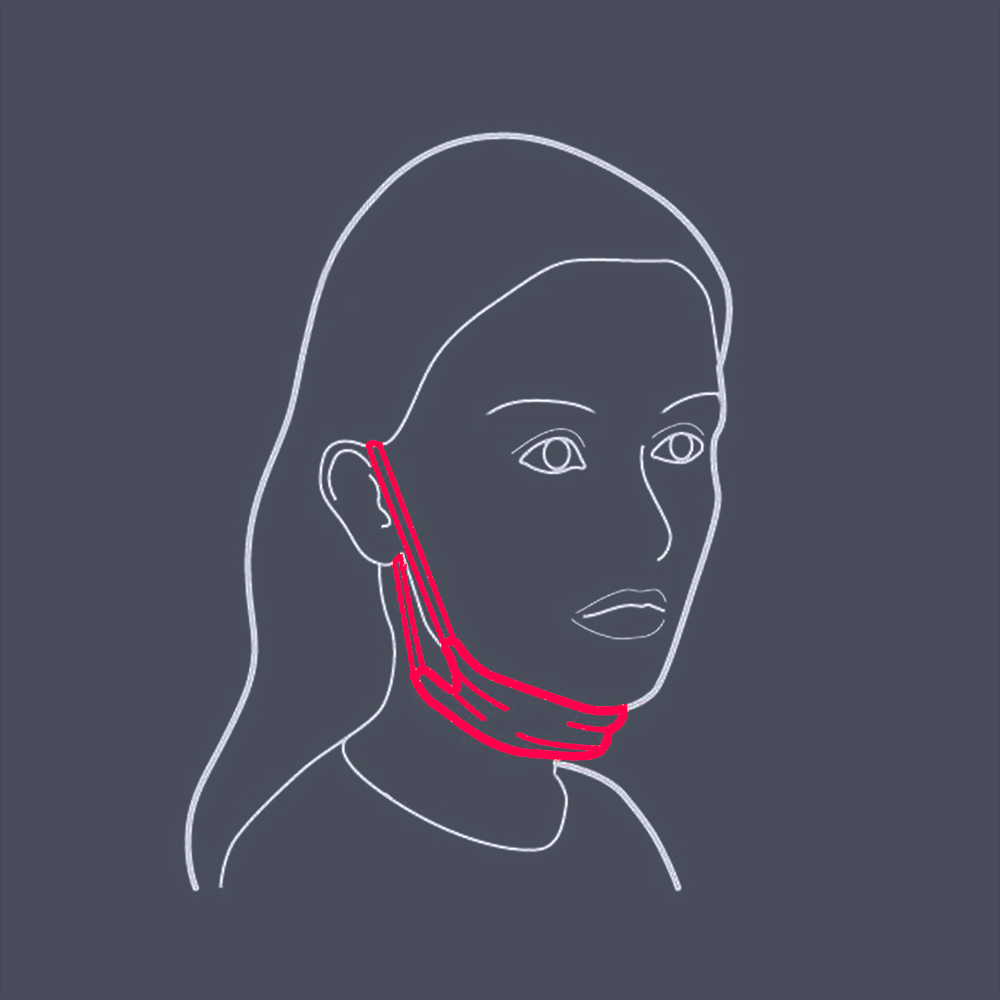 |
| Don't use too large or loosely-fit masks. Ideally, air shouldn't be allowed to flow in or out anywhere else other than through the mask itself. | Don't leave your nose uncovered or outside the mask. Covering only your mouth puts you in danger and renders the mask totally useless. | Don't rest your mask on your neck or under your chin. Not only are you contaminating it, but you're also becoming unprotected for the time being. |
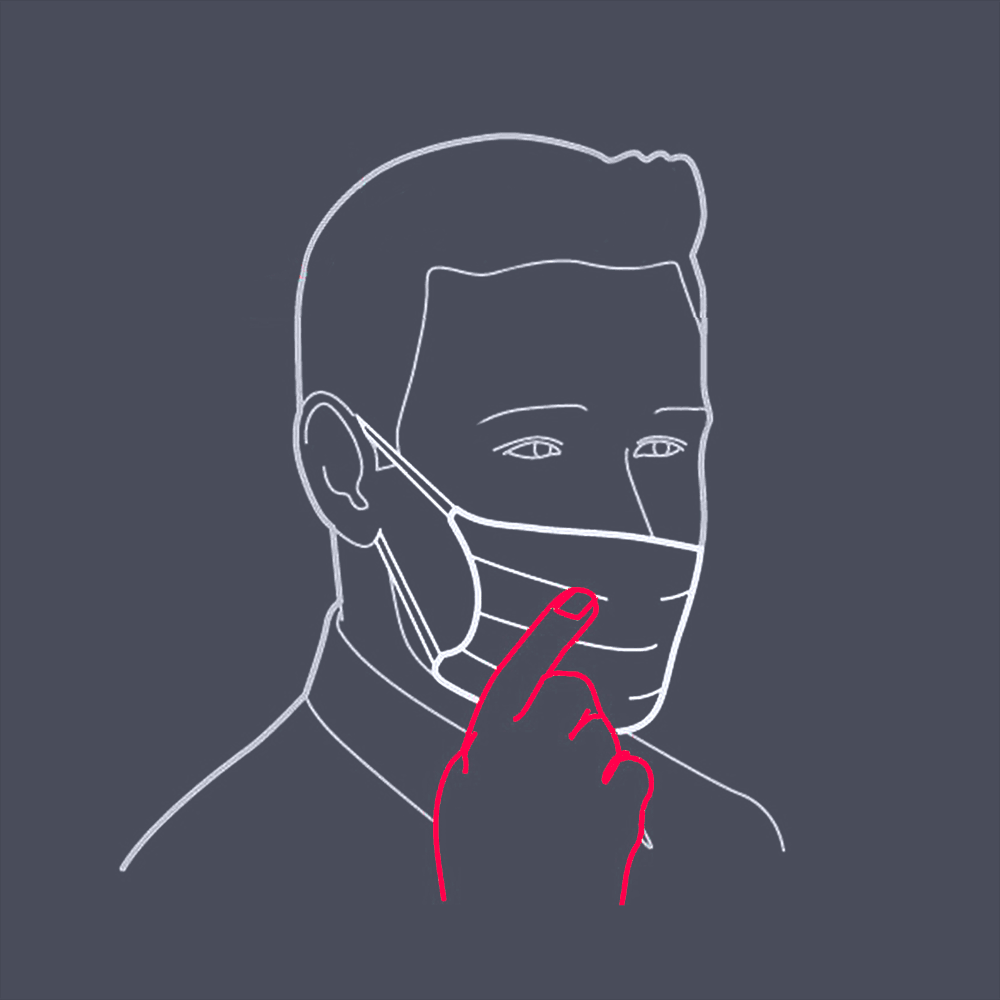 |
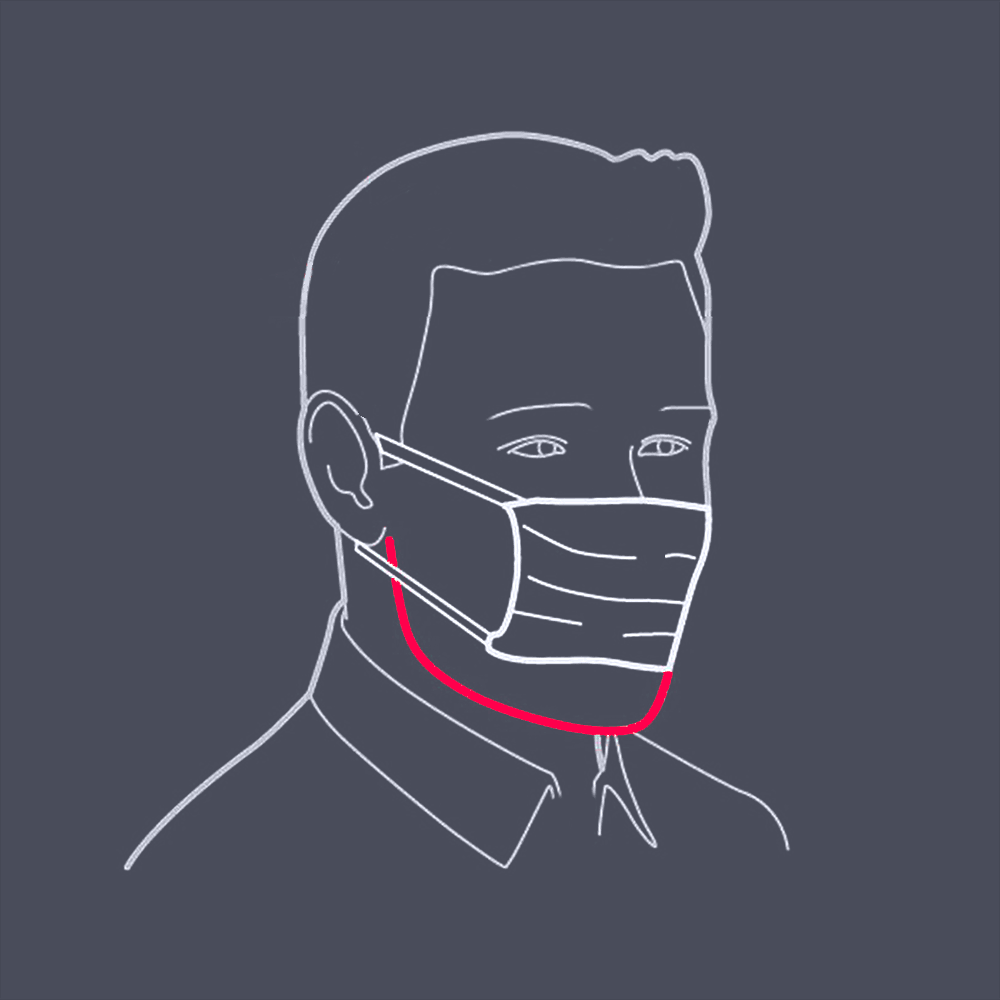 |
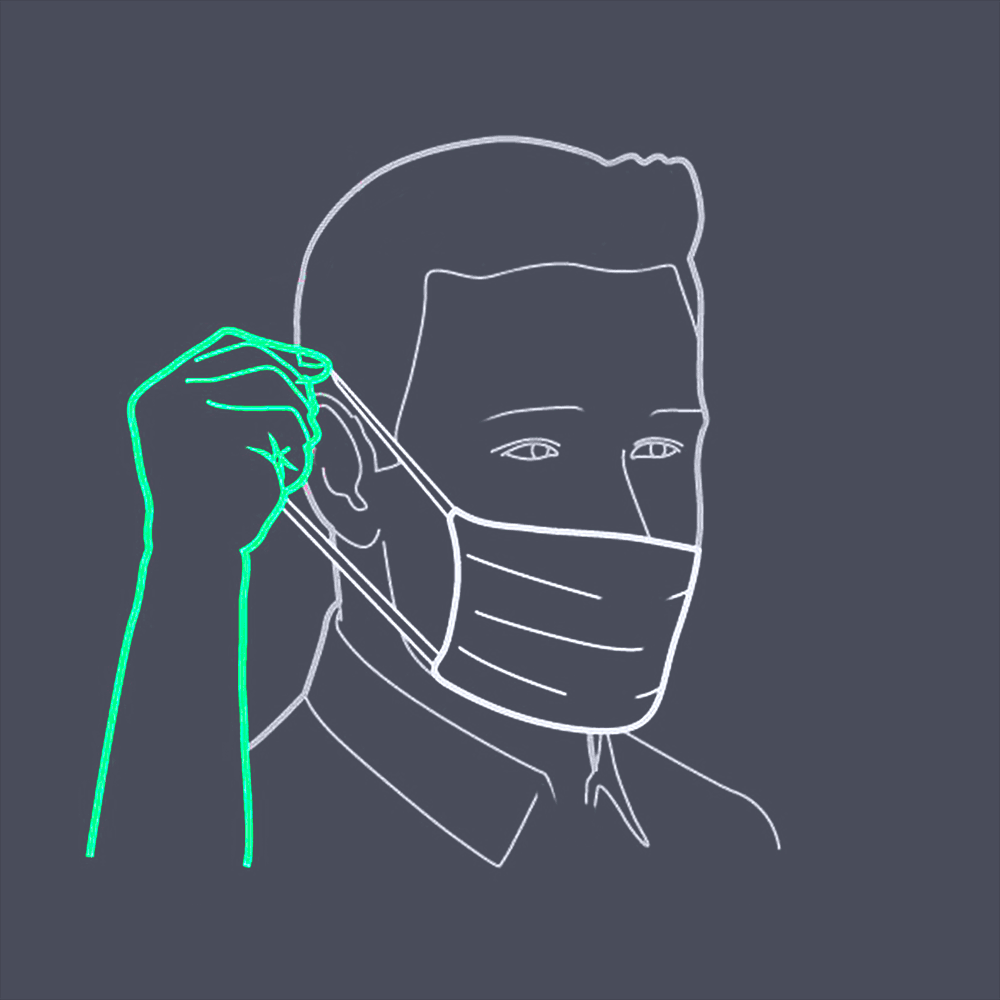 |
| Never touch or remove your mask by pulling the front of it. The front of the mask is exactly where dirt, bacteria and viruses may stay for a while. | Don't leave your chin or lower part of your face exposed. If this is happening, that's probably because the mask size is too small for you. | Always remove, put or pull your mask only by holding its strings. Never touch the mask body directly in order to avoid contamination. |
How to sanitize your mask
Furthermore, knowing how to properly clean your mask is as important as using it right. Every time you use a mask, sweat, saliva, skin impurities, bacteria and other elements will impregnate the inner side of it, while other elements from air pollution, smoke and viruses will stick outside. If your mask is disposable, it must be discarded immediately at the end of the day or after a few hours of use, depending on the product instructions, but many masks are reusable, and they are the ones that require good care in order to keep them safe for use after use.Remember: if your mask is disposable (e.g. paper or surgical type) it must be discarded after use. You should never attempt to clean or keep a disposable mask to be used multiple times. Furthermore, if your mask is home-made or made of cloth, it must be washed on a daily basis in addition to the cleaning tips listed below.
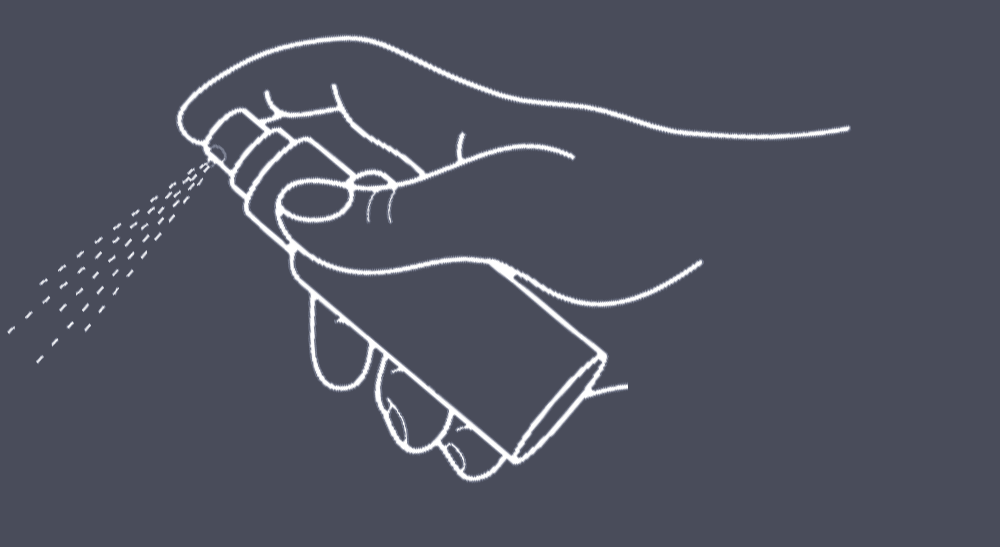
One of the fastest, easiest and most efficient way is to use a Disinfectant Spray. Brands like Lysol, Dettol or Dover (Japan) offer great products, but you may also want to look for food-grade cleaning sprays for baby use, which won't trade efficiency for strong smell or chemical residues. If you use a spray, it's important not to make the mask too wet. Just a gentle and short spray (on each side) is enough to kill any bacteria on both sides of the mask. Let it dry for a few minutes and store your mask in a dry and dust-free compartment like a paper envelope or box.
If you're using sprays, special attention is needed if your mask has a valve or replaceable filters. Make sure the disinfectant spray doesn't reach the inner part of the valve or the filter. If the filter is removable, you may want to remove the filter first, in addition to using a sticky tape to cover all valve orifices.
Another method, which is also quick and easy, but may damage your mask, is to use Antibacterial Wipes, especially the skin-friendly or food-grade ones. This method requires more attention in order to avoid touching the inner side of the mask. Very important: never use the same tissue to clean both sides of the mask. You should use one just for the inner side and a new one for the outside. Just like the spray method, it's important to let the mask dry before storing it in a dry and safe place.
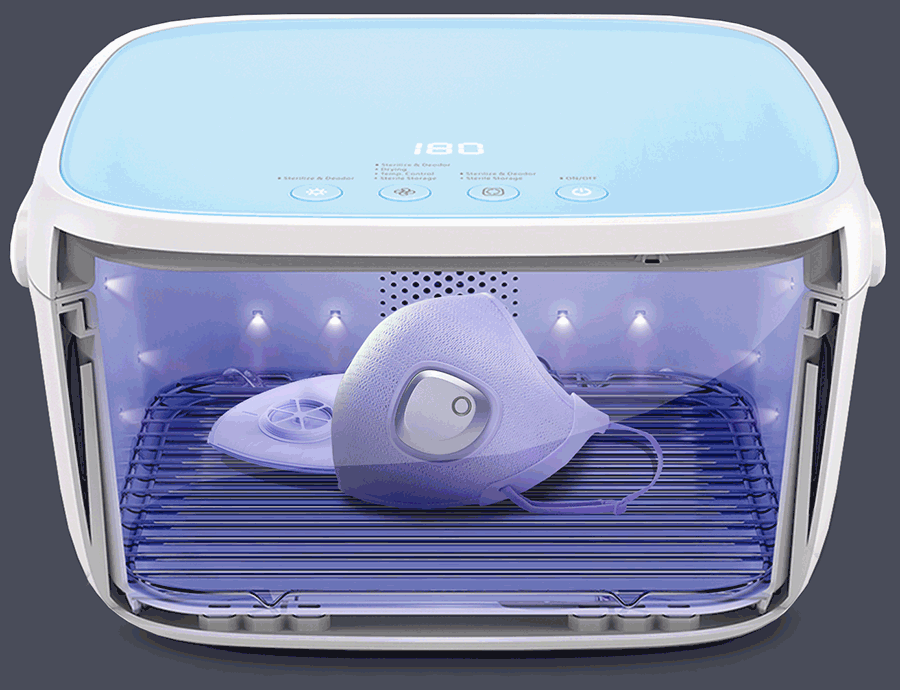
Another sanitizing method consists of placing the mask in a preheated oven, which isn't too practical and can easily damage, if it doesn't end up destroying, your reusable mask, especially if it has plastic parts or valves, so you better stay with sprays, UV light and wet tissues.
To valve, or not to valve?
That's an important question that can raise looks or angry stares among a more educated public. Many respirators and personal-use masks offer a ventilation valve that makes breathing easier and comfortable. These valves are designed to stay closed when the user inhales, and to open during exhalation. This mechanism greatly reduces humidity and temperature inside the mask. It's an important feature in hot environments or under extreme conditions, when increased breathing requires a higher and faster inflow and outflow of air.Despite being a feature that benefits the user, such valves are not so beneficial for others around it. In a perfect scenario, masks (when used for medical purposes) are supposed to protect us and others around us too, but masks with valves don't do a good job protecting others from our breathing and potential issues or viruses that come with it.
Wearing masks with valves is still better than wearing nothing at all when we sneeze or cough. Valves may not completely block particles from flowing outside the mask, but they still greatly reduce particulate propagation in the air.
It's recommended to use valved respirators or masks only when you're performing (non-medical) professional or personal tasks alone, keeping a safe distance from others and tested against health problems or diseases that may spread through the air. These activities may include painting, sawing, constructing, polishing, outdoor exercising, and so on. If you're using masks for personal use in crowded spaces, it's appropriate and more considerate to use masks without valves.
Conclusion
So, what mask type is the best for me? That's a difficult question without a precise answer. The best way to get it answered is to fully understand your needs and the environment around you.If you're not a medic, health worker or a professional dealing with unwanted particles from the work environment (chemicals, construction, painting, sawing, etc), medical respirators are probably not for you. The industry should do more in terms of design and comfort, so the wide range of professionals that rely on such equipment could benefit from it.
If you live in urban or densely-populated areas, and your goal to stay safe & protected from pollution, bacteria and viruses, a high-quality reusable mask with multi-layer filtering system may be just the perfect match as they combine safety, style and comfort, something that you won't find in professional respirators or surgical/paper masks.
